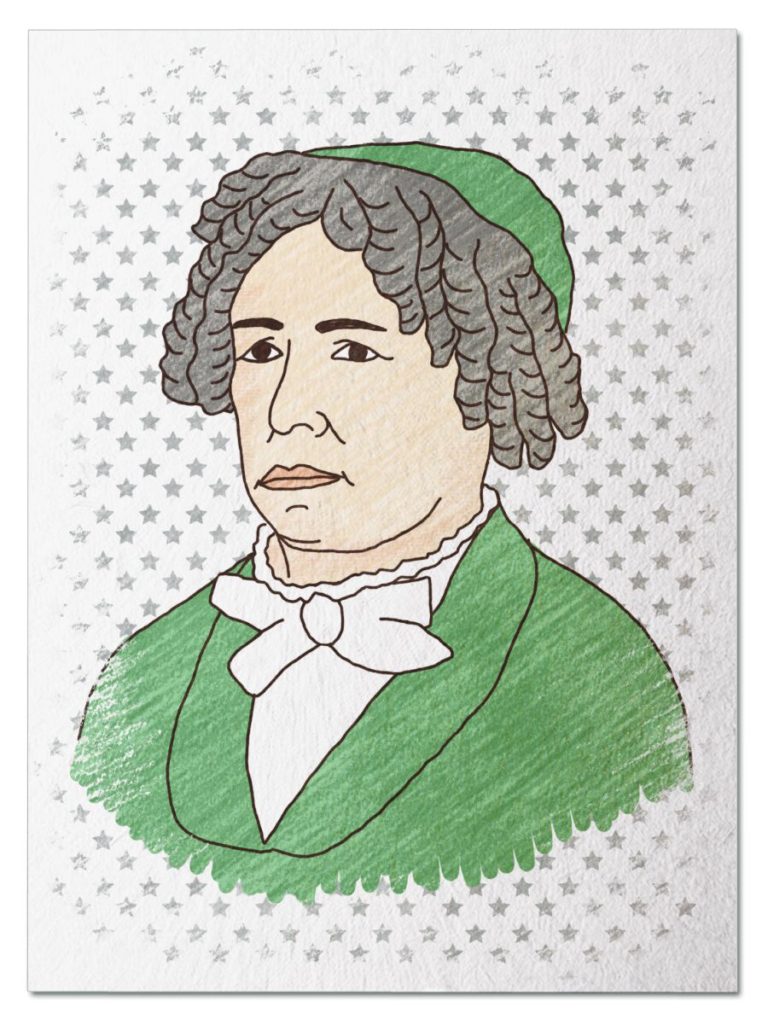
Super Scientist
She spent much of her childhood stargazing through a telescope on the roof of her childhood home, and turned that youthful pastime into a career as the first professional woman astronomer in the United States. She discovered a comet, was the “Computer of Venus,” and fought for women in science as a Professor at Vassar College. Transport yourself to a grassy field outside of Denver during the July 29, 1878 total eclipse and observe its wonder with Maria Mitchell…
Her Ruby Shoe Moment
The Power of the Wand
Her Yellow Brick Road
Brains, Heart & Courage
Glinda’s Gallery
Just the Facts
Her Ruby Shoe Moment
Professor of Astronomy Maria Mitchell looked around the Pacific Railroad car at the women seated around her. It was wonderful to be surrounded by some of her favorite students again. She had missed their sharp minds and probing questions since they had graduated from Vassar College. Now they were together, crossing the country by rail on their way to Denver, Colorado. Maria had invited them to join her on an expedition to observe the upcoming total solar eclipse on July 29, 1878.
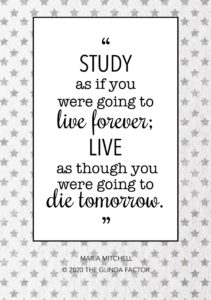 Studying a total eclipse is one of the highlights of an astronomer’s career. The moon moves between the sun and the earth to form a straight line. As the moon casts a shadow onto earth, the light of the sun is completely blocked. The solar corona, which is the outermost part of the sun’s atmosphere, becomes visible around the dark circle of the sun. This provides a special opportunity for study, as sunlight usually hides it from view. Total darkness lasts only a few minutes, until the moon moves out of alignment. While an eclipse occurs approximately every 18 months, the shadow can be cast anywhere in the world, and is typically only 50-150 miles wide. Having one within traveling distance was a rare treat.
Studying a total eclipse is one of the highlights of an astronomer’s career. The moon moves between the sun and the earth to form a straight line. As the moon casts a shadow onto earth, the light of the sun is completely blocked. The solar corona, which is the outermost part of the sun’s atmosphere, becomes visible around the dark circle of the sun. This provides a special opportunity for study, as sunlight usually hides it from view. Total darkness lasts only a few minutes, until the moon moves out of alignment. While an eclipse occurs approximately every 18 months, the shadow can be cast anywhere in the world, and is typically only 50-150 miles wide. Having one within traveling distance was a rare treat.
The Europeans were leaders in scientific innovation, and blamed democratic government for the United States’ scientific deficiencies. A total eclipse on its soil was a perfect opportunity for the United States to prove it could compete, so the government offered to pay all expenses for several groups of male scientists to travel to the path of the eclipse. Even though Maria was a famous astronomer and well-known Vassar professor, she was not offered a grant.
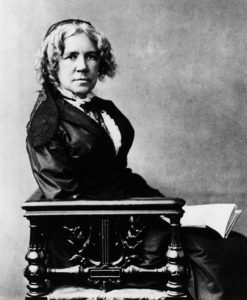
Maria Mitchell
Maria was about to turn 60 and was frustrated by this lack of support. She had been working to persuade the public for years that women could be scientists. She was tired of listening to those who claimed science education taxed female brains and atrophied their reproductive organs. Maria knew that a group of women astronomers could do the work as well as the men. The narrow band of the moon shadow, where there would be 3 minutes of absolute darkness, carved a path from Montana through Texas. As Maria described it, “each astronomer selected his bit of darkness on which to locate the light of his science.” She chose Denver.
It was an 1800 mile trip by rail and the women dealt with many mishaps along the way, including lost luggage. They set up camp just outside of Denver, overlooking the plains to the east and the Rocky Mountains to the west. They had wooden chairs, a small tent for shade, three telescopes, and other instruments. They set up their chronometer, which measured time to the tenth of a second and calibrated it every hour as conditions changed.
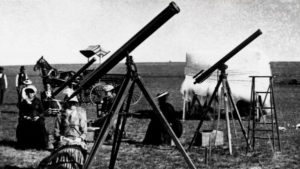
Maria’s group of astronomers in Denver studying the total eclipse (Vassar College).
The novelty of a group of women scientists attracted much attention from the public and press. On the day of the eclipse, they had an audience. As the inky black spots of shadow began to appear on the sun, marking the beginning of the eclipse, one of them watched the chronometer and counted the seconds for those at the telescopes. Some used took pictures of the sun. Others began using a spectroscope to break down the light into its component colors to learn more about the sun’s chemistry. Different colors correspond with various elements, like copper and sodium.
The day got darker. Finally, in Maria’s words, “as the last ray of sunlight disappeared the corona burst out, all around the sun, so intensely bright near the sun that the eye could scarcely bear it.” After three minutes of total darkness, the women turned their attention to the southeast and watched the “black band of shadow” move away. The entire eclipse took about an hour.
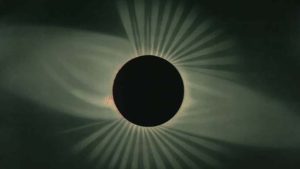
The solar corona of the July 29, 1878 total eclipse (NY Public LIbrary)
Three months after the eclipse, Maria was a featured speaker at the Women’s Congress. Her all-women expedition had been written about in newspapers nationwide, and her lecture attracted more than 1000 people. Maria, who believed in using art to enhance science, used poetic language with great effect. Even the local paper grudgingly admitted that “Professor Maria Mitchell of Vassar, who came to describe the solar eclipse at Denver with graphic and beautiful language, must have satisfied every man fortunately present that the highest scientific attainment is compatible with true womanliness.”
The Power of the Wand
Maria was the first woman professional astronomer in the United States. Her top priority was to make science education available to girls and women. Her quick wit and sense of humor inspired her students. As one said “a chance meeting with Miss Mitchell … gave one always an electric shock. At the slightest contact, a spark flashed.” Maria studied the 17th century friendship between Italian astronomer Galileo and English poet John Milton, which inspired her to look for the poetic beauty in science. Maria loved writing about her discoveries and carried a notebook around with her everywhere.
Today, Dr. Aomawa Shields is merging her work as an astronomer with her theater and writing background to inspire girls of all backgrounds to embrace science education. She is the founder of Rising Stargirls, an organization that provides workshops and curriculum that combines astronomy with interactive theater, writing, and visual art. Rising Stargirls is “committed to the idea that there is no one way to be a scientist, and that together, both science and the arts can create enlightened future scientists and imaginative thinkers.”
Her Yellow Brick Road
In 1832, King Frederick VI of Denmark, who was fascinated by astronomy, announced that he would award gold medals for the first sighting of any new comet anywhere in the world. The catch: it had to be detectable only by telescope, not something the human eye could see. Maria had an ideal place to set up her telescope to search for something new: the rooftop of the Pacific National Bank in Nantucket where her dad worked. She spent night after night scanning the sky with her telescope.
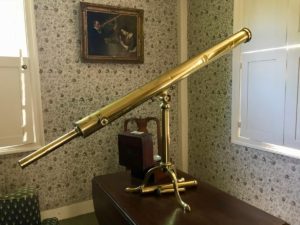
Maria used this telescope to discover “Miss Mitchell’s comet” (Brian Morris WCAI).
On October 1, 1847, Maria noticed something new moving above Polaris, the North Star. She checked double checked her astronomical charts and realized she had discovered a comet. But before she published her preliminary notice of discovery on November 12, an Italian astronomer published his own notice and claimed the prize. Maria had to present evidence that she had seen the comet first. Fortunately, she was able to do so and the dispute was resolved in her favor, she took home the King’s prize, and her C/1847 T1 comet was nicknamed Miss Mitchell’s Comet.
Maria became a celebrity after her discovery. A woman astronomer was a novelty and the public sought her out at the library where she worked, disrupting its once quiet sanctuary. She moved to Boston in 1849 with her dad, and the U.S. Nautical Almanac hired her to track the orbit of Venus for their sea navigation tables. Maria, as “the computer of Venus,” was the first woman ever hired by the U.S. government for a “specialized non-domestic skill.”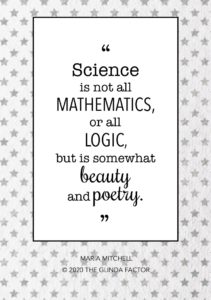
Europe was the center of astronomy, and Maria dreamed of visiting. She finally got the chance when she chaperoned a banker’s daughter on a trip in 1857. She visited the Greenwich and Berlin observatories and met several fellow astronomers, including the Vatican astronomer, Angelo Sacchi. He helped Maria become the first woman inside the Vatican Observatory. Even with his intervention, she was only granted permission to enter during the day – not an ideal time to stargaze! Another highlight was meeting her idol, British mathematician and writer Mary Somerville. The two of them spent hours talking about their scientific passions.
In 1865, Vassar College for women opened and offered Maria a Professor of Astronomy position, paying $800 a year. She soon discovered that her male colleagues were paid more and successfully fought to be paid the same. Vassar built one of the best observatories in the country, with a 12 inch refracting telescope built for Maria by famed telescope manufacturer Henry Fitz.
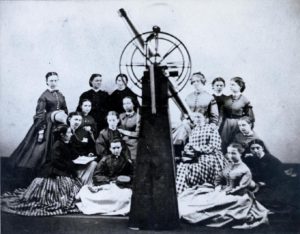
Maria and her astronomy students (Vassar)
Maria lived in an apartment in the observatory, and spent her days teaching and researching in its 28 foot dome, which required 16 cast-iron pulleys to turn it. Maria became a beloved mentor to the astronomy students. She hosted an annual “Dome Party” featuring poetry, astronomy, and strawberries and cream. Maria included her students’ research in her own work and always credited their discoveries.
Maria observed her first total solar eclipse on August 7, 1869. She arrived in Iowa with a group of scientists 3 days early to set up and test their equipment, but the weather didn’t cooperate. Maria feared the trip would be a failure, but the skies cleared the morning of eclipse and Maria experienced a sight she would never forget:
“As the moon moved on, the crescent sun became a narrower and narrower golden curve of light, and as it seemed to break up into brilliant lines and points, we knew that the total phase was only a few seconds off. Mississippi looked dark grey. Venus and Mercury shining on either side of sun. Animals reacted. Cattle lowing, birds crying. A moment of complete darkness and then: Instantly the corona burst forth, a glory indeed! It encircled the sun with a soft light, and it sent off streamers for millions of miles into space!”
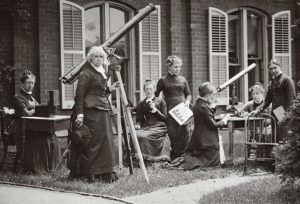 Maria continued teaching, writing, lecturing, and traveling after Iowa, including a trip to a Russian observatory near St. Petersburg in 1873. She gave one of her most famous speeches, “The Need for Women in Science” at the Fourth Congress of the Association for the Advancement of Women in 1876. She also gave thanks for her good fortune that there would be another total eclipse on American soil in 1878.
Maria continued teaching, writing, lecturing, and traveling after Iowa, including a trip to a Russian observatory near St. Petersburg in 1873. She gave one of her most famous speeches, “The Need for Women in Science” at the Fourth Congress of the Association for the Advancement of Women in 1876. She also gave thanks for her good fortune that there would be another total eclipse on American soil in 1878.
Brains, Heart & Courage
Maria grew up in a whaling community on Nantucket Island in Massachusetts. Her family, in Quaker tradition, believed that boys and girls should educated equally. Her dad worked at the local bank, but in his spare time, loved to study the stars. He also worked with chronometers, which were ships used to measure time while sailing through variable conditions. He included his daughters in his astronomy adventures and taught them how to use a chronometer.
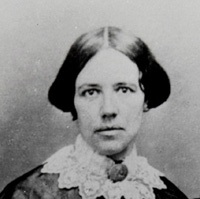 Maria spent much of her childhood on the roof with her dad, using a telescope to examine the night sky. Her dad knew astronomers at Harvard University’s observatory who provided him with charts and data. Maria was very observant and enjoyed math, both of which helped her understand the movement and colors of the stars.
Maria spent much of her childhood on the roof with her dad, using a telescope to examine the night sky. Her dad knew astronomers at Harvard University’s observatory who provided him with charts and data. Maria was very observant and enjoyed math, both of which helped her understand the movement and colors of the stars.
When Maria was 12, she and her dad decided to calculate the longitude and latitude of their house using information gathered while observing a solar eclipse. She kept practicing navigation using the stars, and by the time she was 14, was making navigation charts for whaling ships to keep them on target during their long journeys.
Maria believed that students learn best through experience, and opened her own school when she was 17. The following year she also took over operations at the local library, the Nantucket Atheneum.
Glinda’s Gallery
Just the Facts
- Maria was born on August 1, 1818 on Nantucket Island.
- Maria was 32 when she was elected to the American Academy of Arts and Sciences. She was the first, and only woman member until 1943. She also was the first woman admitted to the American Association for the Advancement of Science. She co-founded the Association for the Advancement of Women in 1873.
- Maria was one of the first to write about how people watching the same event will see it differently, noting that “no one person can give an account of this eclipse, but the specialty of each is the bit of mosaic which he contributes to the whole.” For example, while two people call the same color orange, they cannot know what each other’s orange looks like.
- Maria loved writing and poetry and kept detailed journals of her discoveries, observations, and travels.
- Maria retired from Vassar College in 1888. She died only a year later, on June 28, 1889. She kept a telescope by her window until her death.
- Maria’s legacy is far reaching. Vassar keeps curated archives of her work. Nantucket hosts the Maria Mitchell Association, which operates two observatories, a natural science museum, an aquarium and her childhood home. Maria’s Henry Fitz telescope is displayed in the Smithsonian National Museum of American History.
- Since her death, astronomers have named two discoveries after her. The asteroid “1455 Mitchella” (discovered in 1937) and lunar impact crater on the moon named “Mitchell.”
- Maria’s plate of solar photos was rediscovered in a Vassar observatory closet in 1997.
- The next total solar eclipse in the United States will take place on April 8, 2024. The path of totality will extend from Texas to Maine and be 100 miles wide.
Want to Know More?
Mitchell, Maria. Maria Mitchell: Life, Letters, and Journals, 1896 (Forgotten Books 2012).
Albers, Henry (Editor). Maria Mitchell: A Life in Journals and Letters (College Avenue Press 2001).
Bergland, Renée. Maria Mitchell and the Sexing of Science: An Astronomer Among the American Romantics (Beacon Press 2008)
Maria Mitchell Association Website
Baron, David. “A Woman in Eclipse: Maria Mitchell and the Great Solar Expedition of 1878” (Undark Aug. 17, 2017).
Baron, David. “The Eclipse That Made America Great” (The Atlantic Aug. 9, 2017).
Holmes, Richard. “Maria Mitchell at 200. A Pioneering Astronomer Who Fought for Women in Science.” (Nature June 26, 2017).
NASA. “What Is An Eclipse?” (NASA.gov May 3, 2017)
Popova, Maria. “The World’s First Celestial Spectator Sport: Astronomer Maria Mitchell’s Stunning Account of the 1869 Total Solar Eclipse.” (Brainpickings July 17, 2017).
